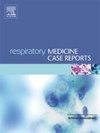1例EGFR外显子19缺失/插入突变(T751_I759delinsS)的肺腺癌对奥西替尼有反应
IF 0.7
Q4 RESPIRATORY SYSTEM
引用次数: 0
摘要
表皮生长因子受体(EGFR)酪氨酸激酶抑制剂可有效治疗EGFR突变阳性的非小细胞肺癌。然而,EGFR突变的多样性提出了一个挑战,因为罕见变异的治疗策略仍然不明确。2019年9月,一名29岁的不吸烟男子因背部疼痛就诊于他的主治医生。胸部计算机断层扫描显示右肺和胸膜多发结节性病变,诊断为起源于右肺中叶的肺腺癌(cT4N1M1a, IVA期)。使用CobasⓇEGFR突变检测试剂盒v2.0进行初始测试,使用实时聚合酶链反应(PCR), EGFR突变结果为阴性。患者随后转到我院接受进一步治疗。2020年1月,他开始使用阿特唑单抗、贝伐单抗、卡铂和紫杉醇联合治疗。此外,在我们医院进行了支气管镜检查,以确定潜在的未被发现的驱动基因突变。作为临床试验的一部分,新一代测序(NGS)分析显示存在pT751_I759 delinsS,这是一种罕见的EGFR外显子19缺失插入突变变体。伴随诊断试验通过多肽核酸锁定核酸pcr夹钳法复查确认突变。在之前的治疗方案失效后,奥西替尼于2021年4月开始使用。观察到肿瘤缩小,治疗持续11个月。本病例涉及一位被诊断为肺腺癌的年轻患者。鉴于临床表现,强烈怀疑驱动基因突变。NGS鉴定出罕见的突变pT751_I759delinsS,研究结果提示奥西替尼对这种变异的潜在疗效。本文章由计算机程序翻译,如有差异,请以英文原文为准。
A case of lung adenocarcinoma with EGFR exon 19 deletion/insertion mutation (T751_I759delinsS) showing response to Osimertinib
Epidermal growth factor receptor (EGFR) tyrosine kinase inhibitors are effective for treating EGFR mutation-positive non-small cell lung cancer. However, the diversity of EGFR mutations presents a challenge, as treatment strategies for rare variants remain undefined.
A 29-year-old nonsmoking man presented to his primary physician in September 2019 with back pain. Chest computed tomography revealed multiple nodular lesionsin the right lung and pleura, leading to a diagnosis of lung adenocarcinoma originating in the right middle lobe (cT4N1M1a, stage IVA). Initial testing with the CobasⓇ EGFR Mutation Detection Kit v2.0, using real-time polymerase chain reaction (PCR), yielded negative results for EGFR mutations. The patient was subsequently referred to our hospital for further treatment. In January 2020, he began combination therapy with atezolizumab, bevacizumab, carboplatin, and paclitaxel. Additionally, a bronchoscopy was conducted at our hospital to identify potential undetected driver gene mutations. Next-generation sequencing (NGS) analysis, performed as part of a clinical trial, revealed the presence of pT751_I759 delinsS, a rare EGFR exon 19 deletion–insertion mutation variant. The companion diagnostic test confirmed the mutation through re-examination using the peptide nucleic acid-locked nucleic acid PCR-clamp method. After the previous treatment regimen lost efficacy, osimertinib was initiated in April 2021. Tumor shrinkage was observed, and the treatment was sustained for 11 months.
This case involved a young patient diagnosed with lung adenocarcinoma. Given the clinical presentation, a driver gene mutation was strongly suspected. NGS identified the rare mutation pT751_I759delinsS, and the findings suggested the potential efficacy of osimertinib for this variant.
求助全文
通过发布文献求助,成功后即可免费获取论文全文。
去求助
来源期刊

Respiratory Medicine Case Reports
RESPIRATORY SYSTEM-
CiteScore
2.10
自引率
0.00%
发文量
213
审稿时长
87 days
 求助内容:
求助内容: 应助结果提醒方式:
应助结果提醒方式:


